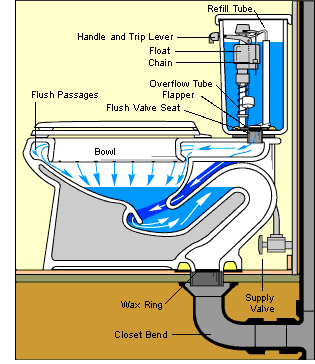 Toilets
ToiletsToilets have two main parts: a tank and a bowl. The tank, which houses all the working parts,
is where various types of toilets differ the most. Several different
types of mechanisms are used to accomplish a toilet's basic
operation—to flood the bowl with enough water to flush waste down
the drain and then refill the tank and bowl with fresh water.
Here is how the most common mechanism works: When you flush the
toilet, the handle lifts and a stopper, called the flush valve, releases the water from the
tank into the toilet bowl. The resulting water pressure forces the
contents of the bowl into the drainpipe.
As the tank empties, a float ball that floats on the top of the
tank water drops. This activates a ball cock or water valve, which opens a
water-supply valve that refills the tank. (Some toilets do not have
the float ball and work through water pressure.) As the water fills
the tank, the ball floats back up, and when the water reaches the
right height in the tank, it shuts off the valve.
A bend in the pipe just below the toilet serves as a water-filled
trap that blocks the rise of sewer gases.
Waste drains to a municipal sewer or to a septic tank.
Low-Flow Toilets |
|
|
Toilets: Introduction I Common Problems I Easy Repairs | |